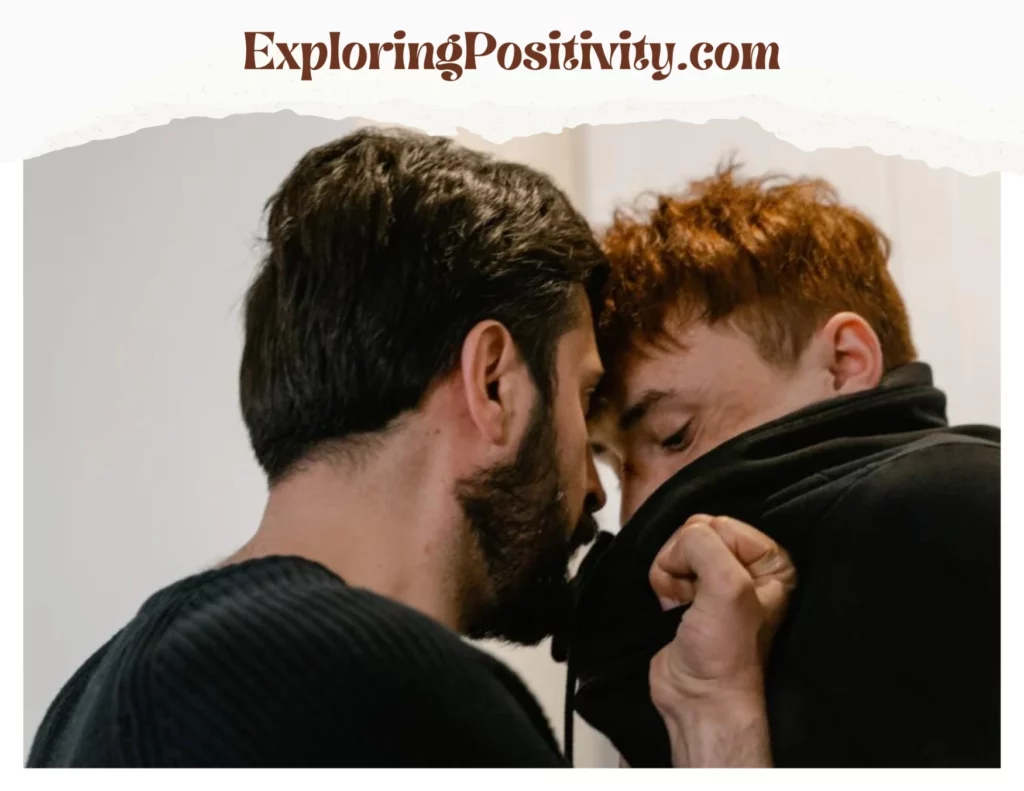Trauma bonds, also known as Stockholm syndrome, refer to the emotional attachments formed between victims and abusers in abusive relationships. These bonds make it incredibly difficult for victims to leave their abusers, even when the connection is objectively unhealthy or dangerous.
Despite the challenge (Can a Trauma Bond be Fixed), trauma bonds can be broken with proper techniques, social support, and an unyielding personal commitment to healing.
When a victim is recurrently abused, threatened, or manipulated by their partner, their biology responds by releasing hormones like oxytocin and cortisol. These create a trauma response and unconsciously bond the victim to their abuser.
The abuser then employs insidious tactics like gaslighting, love bombing, and conditioning to strengthen this one-sided attachment. Victims become trauma-bonded to their abusers in a way that resembles addiction or obsession. They may minimize the abuse, make excuses for their partner, or repeatedly return to them hoping they will change.
Trauma bonds often form due to the psychology of intermittent reinforcement. Abusers alternate loving behaviors with cruelty, keeping victims confused and hooked on the expectation of the caring treatment returning. This muddles the victim’s thinking, destroys their self-esteem, and strengthens their trauma bonding.
Despite feeling anxious or fearful much of the time, victims occasionally experience relief or joy when their abusers treat them well. Their neurotransmitters fire erratically, much like those of a gambling addict. This conditions them over time to ignore the abuse and cling to their abuser.
The World Health Organization reports that 1 in 3 women worldwide experience physical or sexual violence by an intimate partner. Of U.S. women murdered each year, over half are killed by romantic partners.
Still, many remain unaware they are being abused, blame themselves, or feel trauma bonded too strongly to their abusers to escape. Breaking these powerful attachments requires concerted effort, expert help, and an unwavering dedication to one’s safety and freedom.
Though difficult, thousands heal from abusive relationships annually by utilizing trauma-informed counseling, domestic violence resources, no-contact rules, and peer support. By better understanding the psychology behind their trauma bonding, abuse survivors can logic their way to freedom.
They can grieve the fantasy of who they wanted their abuser to be, establish healthy new relationships, and embrace a life no longer defined by victim-hood. With time, professional help, and commitment to cutting contact, survivors can break free from even the most intense trauma bonds.
This article (Can a Trauma Bond be Fixed) will examine common barriers that prevent victims from leaving, as well as proven techniques for escaping abusive relationships, processing trauma, and breaking detrimental attachment bonds.
While challenging, there is hope for all those trauma bonded to their abusers. For those who reach out for support and dedicate themselves fully to healing, recovery is possible.
Mechanics of Trauma Bonds, How They Form and Operate
Trauma bonding occurs due to the insidious psychological tactics of abusers, as well as the biological responses of victims to recurring abuse. Abusers employ manipulation and conditioning to foster an unhealthy attachment, while victims unconsciously use defense mechanisms and cognitive distortions to survive the abuse. Understanding the psychological and biological drivers behind trauma bonding is vital to breaking its powerful grip.
Intermittent Reinforcement
Abusers use a tactic known as intermittent reinforcement to keep victims bonded. They alternate loving, attentive behavior with cruelty, threats, or neglect. The periodic “rewards” of affection strengthen trauma bonding, much like random rewards encourage gambling addictions.
The abuser’s spontaneous, positive behaviors function like short hits of oxytocin and dopamine, chemicals that promote trust and bonding. Victims become addicted to chasing these bonding highs during periods of affection while suppressing the abuse and trauma.
Conditioning Through Manipulation
Abusers also condition victims to accept poor treatment through insidious manipulation tactics like gaslighting, love bombing, and enforced isolation. Gaslighting convinces victims that the abuse either didn’t happen or was their fault. Love bombing shows victims gifts and praise early in the relationship to build trust.
Isolation cuts victims off from outside support. These tactics gradually normalize the abuse and strengthen victim loyalty. The longer someone remains under the manipulation of an abuser, the stronger their trauma bonding grows. They start defending or sympathizing with their abuser due to the conditioning.
Cognitive Distortions
To endure recurring abuse, victims frequently develop cognitive distortions like denial of the abuse, minimization of harm, or assuming responsibility for the abuser’s choices. Trauma bonding depends heavily on such distortions, which allow victims to suppress reactions for self-preservation.
For example, a victim may justify physical abuse by telling themselves, “At least he doesn’t hit me in the face.” Or they may blame themselves, thinking, “If only I kept the house cleaner, she wouldn’t get angry.” These distorted thought patterns allow victims to excuse abuse and strengthen traumatic attachment to the abuser.
The Biology of Trauma Bonds
In addition to psychology, trauma bonding has clear biological underpinnings. When abused, the victim’s body releases stress hormones like cortisol and adrenaline. Their fight-flight-freeze response activates.
To endure this state for extended periods, the brain suppresses logic and banks on emotion, unconsciously bonding with the abuser for a sense of security. This manifests physically through symptoms like hypervigilance, nervous system dysregulation, immune system disruption, headaches, and insomnia.
The body also releases hormones like oxytocin and dopamine when given occasional affection. These hormones promote bonding, trust, and emotional connection. Their presence during intermittent reinforcement explains why trauma felt like love early in the relationship. The victim’s brain encoded the connection as safe due to their own biology’s response.
Over time, this strengthening of trauma bonding chemically and physically alters the victim’s health, self-image, and psychology. They develop a form of addiction to their abuser. Breaking this addiction requires retraining both mind and body through counseling, mindfulness practices, contact elimination, and social support.

Surmounting Obstacles to Breaking Trauma Bonds
Despite desperately wanting freedom from abuse, many trauma-bonded victims encounter barriers that prevent them from leaving. Abusers deliberately cultivate these obstacles through manipulation tactics. However, victims can overcome these hurdles by acknowledging the challenges and asking for support.
Difficulty Recognizing Abuse
Gaslighting and conditioning by abusers often prevent victims from correctly labeling abuse. Victims may view possessive, controlling behaviors as signs of love. They excuse violations of boundaries, assaults, or emotional cruelty as regular relationship issues. Recognizing the illegitimacy of abuse requires seeking outside perspectives.
Counselors can validate experiences as abusive rather than just unhealthy. Support groups allow connecting with fellow survivors. Once victims reclassify troubling behaviors as abuse, they can begin unshackling their trauma bonds.
Blaming Oneself
Abusers frequently shift blame to victims through psychological intimidation. Victims internalize this blame, experiencing misplaced shame and guilt. They ruminate endlessly on what they did to “provoke” abuse. Trauma bonding demands victims absolve abusers of responsibility. Counseling helps victims redistribute blame appropriately, save themselves, and direct anger outward at the abuser rather than inward.
Fear, Obligation, Guilt
Abusers cultivate fear in victims through threats, stalking, or violating boundaries. Victims often also feel guilty for perceived relationship failures or obligations to fix the abuser. These negative emotions maintain trauma bonding. Building a personalized safety plan with domestic violence advocates can reduce fear. Counseling addresses misplaced guilt. Support groups remind victims their sole obligation is to protect themselves.
Isolation and Limited Resources
Abusers frequently isolate victims from family and friends. This removes potential support systems. Creating new connections becomes vital. Local domestic violence shelters offer counseling, legal help, housing, childcare, and support groups to aid escape.
Hotlines provide 24/7 crisis counseling. Advocacy organizations help with logistics like transportation, new accommodation, and financial assistance to surmount practical hurdles.
Minimizing abuse
Rationalizing, denying, or minimizing abuse can stem from embarrassment or conditioning. However, objective assessments are critical. Consulting experts like law enforcement, medical providers, counselors, or legal advocates can confirm abuse severity from unbiased perspectives. Journaling also helps establish patterns of worsening abuse. Accepting the reality of escalating harm motivates ending trauma bonds.
Hoping Abuser Will Change
When abuse cycles downwards, victims often cling to hope their partner will reform. Abusers exploit this using superficial charm and empty promises during periods of calm.
However, lasting behavioral change is unlikely without intensive counseling. Further, victims deserve relationships free from abuse in the first place. This hope simply prolongs trauma bonding.
Shame and Helplessness
Victims often feel ashamed of admitting abuse or helpless to improve conditions. However, support groups illustrate others undergoing similar experiences. Therapists emphasize the courage in seeking help.
Focusing on present strengths versus past powerlessness empowers escape. All that matters is committing to change. With determination and support, victims can destroy the illusion of shame or helplessness perpetuated by abusers.
Techniques for breaking trauma bonds
Destroying the addictive pull of trauma bonding requires disentangling from the abuser physically, emotionally, and psychologically. By entirely removing an abuser’s influence and replacing it with healing validation and empowerment, victims can reclaim their lives.
Though challenging, implementing the following strategies with support from professionals and loved ones can successfully shatter trauma bonds over time.
Physical and Emotional Distance
Creating physical distance from one’s abuser limits the avenues for manipulation. This may involve relocating, changing jobs, transferring schools, or securing new contact information. Emotional distance comes by minimizing interactions or refusing to discuss the intimate details of one’s life.
Further severing emotional connection involves avoiding constantly monitoring or discussing the abuser with others. Limit them to an insignificant part of your mind and conversations.
No Contact
Implementing a zero-contact rule blocks an abuser’s access to manipulation or honeymoon periods of affection—no texts, emails, calls, video chats, or stalking on their social media. For co-parents, use a parenting app for only essential communications about children. Beware, trauma bonds can persist even after months of no direct contact due to psychological enmeshment. But limiting access is vital.
Journaling and Introspection
Writing about trauma memories, relationship patterns, abuse tactics, and one’s cognitive distortions can reveal insightful truths. This introspection untangles emotions, defense mechanisms, and irrational hopes. Meditation also increases self-awareness and emotional control. Both practices strengthen resolve by highlighting abusive realities versus fantasy.
Support Systems
Connecting with others provides community, accountability, and a healing perspective. Support groups allow the sharing of experiences and tactics that work. Therapy validates abuse realities and processes trauma. Domestic violence hotlines offer 24/7 crisis counseling. Friends and family can help with housing, childcare, finances, transportation, or emotional nurturing.
Challenging Cognitive Distortions
Notice defense mechanisms like rationalizing abuse. Write down traumatic incidents without excuses or empathy for the abuser. Reframe thoughts with logic such as “no one deserves abuse for any reason.” Psychological exercises like this counteract conditioning that “you caused this.” Repeating empowering mantras boosts self-worth.
Self-Care and Esteem Building
Trauma bonds often destroy self-esteem. Restoring a victim’s sense of value and independence is crucial. Self-care activities like therapeutic hobbies, exercising, proper sleep and diet, or socializing with positive people restore esteem. Consider creating a self-love ritual like daily affirmations. Acts of self-compassion defeat abuser conditioning.
Allowing Grief
The fantasy of the abuser’s redemption must be grieved fully before bonds are released. Suffering is not a linear process. Journaling, counseling, or support groups can help process feelings like guilt, bargaining, anger, and acceptance. Grief affirms victims deserved true love all along.
Mindfulness and Present Focus
Ruminating on the past prolongs trauma bonding. Mindfulness practices emphasize the present – appreciating safety, freedom, and personal power versus past helplessness. Educating oneself about abuse also shifts focus to the future. Life needs no longer revolve around the abuser.
Implementing these strategies mutually reinforces trauma bond dissolution. No single approach alone severs attachment completely. Focus daily on recognizing manipulation, establishing distance, surrounding oneself with support, and narrowing mental focus away from the abuser. In time, their fading influence allows true emotional freedom.

Healing process after breaking trauma bonds
Severing trauma bonds marks the beginning of a challenging but liberating healing journey. With commitment, professional support, and personal resilience, survivors can process traumatic wounds, cultivate healthy relationships, and embrace a life of empowerment after abuse.
Counseling and Support Communities
Regular counseling provides the necessary structure, expert guidance, and validation during the volatile trauma recovery process. Support groups build community with fellow survivors who deeply understand the recovery struggle. These collective resources combat isolation and overwhelm.
They also aid in processing feelings like grief, shame, anger, and guilt in constructive ways. EMDR, exposure therapy, and other modalities process memories so they lose destructive power. Ongoing support provides accountability to remain free.
Maintaining distance
Remaining emotionally and physically distant from one’s abuser enhances recovery. This limits manipulation during moments of vulnerability. Strict no contact must continue even after any legal matters conclude.
Cordiality encourages trauma bonds to reemerge. Emotional and physical distance allows for healthy rewiring of attachment instincts. Avoiding places the abuser may frequent reduces anxiety. Distance sustains freedom.
Developing Healthy Relationships
Relationships based on equality, respect, and trust allow survivors to relearn secure emotional attachments. Support groups connect survivors who understand the recovery process intimately.
Therapists model healthy dynamics. Once ready, intimate relationships with empathetic partners further re-establish attachment security. Focus on cultivating relationships that honor boundaries and validate emotions.
Establishing Safety Nets
Crafting a personalized safety plan with a counselor preempts crises. Identify warning signs of trauma triggers or self-harm urges. List healthy distractions and social supports to activate in moments of distress. Keep crisis hotline numbers handy. Apps like MY3 help establish a support network committed to crisis intervention. Safety plans give control when memories or emotions overwhelm.
Practicing Self-Care and Self-Love
The abuse likely decimated self-esteem. Intentionally nurturing and comforting oneself restores a sense of self-worth. Self-care practices like nourishing meals, adequate rest, regular exercise, enjoyable hobbies and soothing music provide emotional strength during the volatility of processing trauma—daily self-love rituals like journaling positive affirmations battle shame. Victims abused for loving too much must learn to love themselves properly.
Overcoming PTSD
Triggers like anniversary reaction memories often intensify PTSD symptoms like flashbacks, insomnia, hypervigilance, or emotional numbness. However, confronting trauma memories in the safety of counseling diffuses their power.
Medications ease symptoms like nightmares, panic attacks, depression, or anxiety. Support groups share effective coping strategies. Yoga, meditation, exercise, and mindfulness soothe the nervous system. PTSD waxes and wanes, but confronting fears prevents regression.
Preventing Relapse
Strictly enforced no contact, distraction strategies, and social accountability prevent backsliding when trauma bonds beckon. Remain vigilant of manipulation tactics, progress made, and the reality of false hope.
Listing past harms and reading journal entries about those experiences reinforces resolve. Accepting the loss of the fantasy relationship, not just the person, is essential.
Prioritize present peace and rational thinking over past betrayal.
Embracing Life Beyond Abuse
While complex, the trauma recovery process ultimately strengthens survivors with new skills, insights, confidence, and empathy. They reclaim an identity beyond “victim.” Self-defense and assertiveness training provide empowerment. New careers or volunteering aid others.
Once processing is completed, survivors feel wiser yet less burdened. Though scars remain, their capacities expand. They model resilience for fellow survivors. Post-traumatic growth allows one to rediscover one’s true self, evolving even more.
Hope After Abuse and Breaking Trauma Bonds
Though the process of breaking trauma bonds and recovering from abuse is undeniably tricky, growth and happiness are attainable. Millions of former victims now live healthy, fulfilling lives. Their stories illustrate the incredible resilience of the human spirit when given proper support and hope.
Recovery is Possible.
Trauma bonds can feel unbreakable in the moment, but they can be overcome. Given time, professional help, personal insight, and determination, survivors can permanently detach from abusers. Studies show counseling, support groups, mindfulness practices, and cognitive reframing successfully treat trauma bonding.
Contact elimination combined with self-care and healthy relationships sustains recovery. Though challenging, freedom from abuse is an achievable goal with the right resources.
Survivors Thrive After Abuse
Many survivors of domestic violence or coercive control go on to build deeply fulfilling, joyful lives. They cultivate self-love, rewarding careers, egalitarian romantic partnerships, and unbreakable bonds with supportive friends or family.
While scars remain, survivors often feel happier and more empowered than ever. They cherish personal growth, love true friends revealed through the journey, and feel wiser yet lighter without their abuser’s presence. Their stories offer hope.
Anecdotal Examples of Healing
Jane C. endured years of emotional abuse by her narcissistic husband before finally divorcing. Through counseling, she found self-worth again. She built a new chosen family within a local support group. Ten years later, Jane is happily remarried and pursuing her dream career in nursing.
Andrew K. broke his trauma bond with an abusive girlfriend with intensive therapy. Though he relapsed twice, with the help of friends, he maintained no contact. He processed anger through boxing, then later channeled that passion into leading self-defense courses. Today he is fulfilled, dating a kind partner, and helping others escape abuse.
Lisa R. left her gaslighting husband after 30 years of marriage. Through a women’s shelter, she found affordable transitional housing. She bonded with fellow survivors in group counseling. Despite lingering PTSD, she feels freer and more herself than ever before. She is looking forward to this new chapter.
There are thousands more stories of hope. All illustrate that with support, insights, and perseverance, trauma bonds and abuse can be overcome, freeing survivors to rediscover who they truly are.
Resources to Escape Now
If currently trauma bonded to an abuser, know that help is available. Local domestic violence shelters offer counseling, transitional housing, legal support, and community. Hotlines provide 24/7 counseling.
Tell trusted friends and document abuse, which strengthens future legal cases. Above all, know you deserve compassion, freedom, and safety. The National Domestic Violence Hotline is 1-800-799-7233.
The Future is Yours
Fully breaking trauma bonds requires grieving the fantasy relationship, restoring self-worth, establishing healthy dynamics, and processing traumatic memories. The road is daunting. But walking leads to a beautiful life free from manipulation or fear. You possess the power to take the first steps toward hope. Coupling personal resolve with social support clears the path to healing. Freedom from abuse is possible.

Warning Signs to Be Mindful of in Future Relationships
After escaping an abusive relationship, survivors often worry about repeating traumatic dynamics in the future. While hypervigilance has its place in detecting real threats, being overly mistrustful can also prevent healthy intimacy. Moving forward mindfully, trusting one’s instincts, and seeking support around subtle red flags can help identify true risks versus innocent behaviors.
Recognizing Jealousy, Control, and Abuse
Some behaviors indicate an unsafe partner: extreme jealousy and accusations of cheating, isolating you from family/friends, controlling finances or clothing, explosive anger, threats, destroying property, physical/sexual violence, and cruel emotional manipulation.
These are dealbreakers, not misunderstandings. At the first sign of such red flags, safely exit the relationship after documenting the abuse and alerting loved ones. Your safety is the priority.
Trusting Your Instincts
Trauma can erode trust in your judgment, especially around intimate partners. But your instincts evolved as warning mechanisms. An uneasy gut feeling signifies something is off. Do not ignore this just because someone seems charming.
Bring concerns to a counselor or friend for a reality test. Ask yourself, “Would I treat a partner this way?” Intuition detects risks even when logic lags. Believe in your perception.
Seeking Unbiased Support
Abusers condition victims to mistrust their instincts. Protect yourself by consulting unbiased support. A trauma-informed therapist can assess a new partner’s behaviors more objectively. Support groups help spot manipulation disguised as concern. Domestic violence advocates confirm which flags mean flee versus work through issues. Check in regularly with your support network when navigating new relationships.
Subtle Red Flags
Some concerning behaviors resemble intimacy: constant check-ins, intensely passionate beginnings, pressing for quick commitment, and feeling like you’re their “everything.” These It could signal love bombing, enmeshment, or moving too fast. Share your concerns and see how they respond. Love respects personal pace and autonomy. Watch for oversensitivity, blame-shifting, extreme flattery/gifts, or pressure to cut off friends. Address issues calmly but directly.
Avoiding Repeat Patterns
Reflect deeply on your past relationship’s early warning signs you dismissed. Common ones include jealousy, controlling behavior, childish reactions to boundaries, and temper issues. Make a list of what you will no longer tolerate. When those red flags surface in a new partner, reference your list, trust your judgment, and exit. Repeat patterns end when you enforce dealbreakers.
Practicing Cautious Optimism:
Be cautiously optimistic when meeting new people, neither naively trusting nor mistrustful. Get to know their character before disclosing trauma history or committing. Vet potential partners by checking if they respect consent and boundaries.
Observe how they respond to disagreements and treat service staff. Look for consistency between words and actions. Slow, measured intimacy allows for assessing true colors.
Healing emotional wounds makes room for healthy love once you fortify instincts, dealbreakers, and support. Proceeding mindfully, you can detect genuine risks early while giving good-hearted partners a fair chance. With wisdom and hope, find someone who helps you feel safe, respected, and free to be yourself.
Final Thoughts – Can a Trauma Bond be Fixed
Though incredibly challenging, the traumatic attachment bonds that form between abuse victims and manipulators can be permanently severed. With time, professional support, personal insights, and an unwavering commitment to one’s freedom, survivors can detoxify from their abusers’ influence. Implementing no contact, processing the trauma, restoring self-esteem, and building a healthy support network can slowly dissolve those traumatic bonds. Eventually, victims rediscover their inner light.
If you are currently trauma-bonded, know there is hope. You deserve compassion, respect, and liberty. With help from domestic violence hotlines, shelters, counseling, and support groups, you can escape abuse and recover. You will reclaim your life by sharing your story, relying on loved ones, and believing in your resilience.
While challenging, the journey ultimately empowers. You will heal by putting in the work, time, and care. Have faith in your ability to break free. There are also millions of fellow survivors cheering you on. You possess the strength to sever these bonds and live unburdened. The first step is reaching out for support. Freedom awaits.
Some symptoms include making excuses for their behavior, feeling you can’t live without them, withdrawing from friends/family, feeling anxious when apart from them, believing you can “fix” them, and covering up or rationalizing the abuse.
Yes, trauma bonds share many parallels with addiction. The intermittent reinforcement of vitriol and affection triggers the same dopamine responses as addictive substances. Breaking trauma bonds requires retraining the brain.
Trauma conditioning created powerful emotional and neurological attachments, even though the relationship was harmful. Like any habit, it takes time to rewire the attachments, causing you to miss your ex.
It depends on the individual, but typically, 6 months to 1 year of zero contact and active recovery work like counseling. Trauma bonds can persist for years if not addressed through no communication and therapy.




